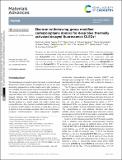Files in this item
Electron-withdrawing group modified carbazolophane donors for deep blue thermally activated delayed fluorescence OLEDs
Item metadata
| dc.contributor.author | Gupta, Abhishek Kumar | |
| dc.contributor.author | Zhang, Zhen | |
| dc.contributor.author | Spuling, Eduard | |
| dc.contributor.author | Kaczmarek, Maria | |
| dc.contributor.author | Wang, Yichuan | |
| dc.contributor.author | Hassan, Zahid | |
| dc.contributor.author | Samuel, Ifor D.W. | |
| dc.contributor.author | Braese, Stefan | |
| dc.contributor.author | Zysman-Colman, Eli | |
| dc.date.accessioned | 2021-09-21T13:30:06Z | |
| dc.date.available | 2021-09-21T13:30:06Z | |
| dc.date.issued | 2021-09-03 | |
| dc.identifier | 275956633 | |
| dc.identifier | d824a0ac-9264-44e8-8dda-04fb59880576 | |
| dc.identifier | 85117689597 | |
| dc.identifier | 000699779100001 | |
| dc.identifier.citation | Gupta , A K , Zhang , Z , Spuling , E , Kaczmarek , M , Wang , Y , Hassan , Z , Samuel , I D W , Braese , S & Zysman-Colman , E 2021 , ' Electron-withdrawing group modified carbazolophane donors for deep blue thermally activated delayed fluorescence OLEDs ' , Materials Advances , vol. Advance Article . https://doi.org/10.1039/D1MA00738F | en |
| dc.identifier.issn | 2633-5409 | |
| dc.identifier.other | RIS: urn:EFF58F094A31D36DB61651B37F2B1B99 | |
| dc.identifier.other | ORCID: /0000-0001-7183-6022/work/100549695 | |
| dc.identifier.uri | https://hdl.handle.net/10023/23993 | |
| dc.description | AKG is grateful to the Royal Society for Newton International Fellowship NF171163. We acknowledge support from the Engineering and Physical Sciences Research Council of the UK (grants EP/P010482/1 and EP/L017008/1). The German Research Foundation (formally Deutsche Forschungsgemeinschaft DFG) in the framework of SFB1176 Cooperative Research Centre “Molecular Structuring of Soft Matter” (CRC1176, A4, B3, C2, C6) and the cluster 3D Matter made to order all funded under Germany's Excellence Strategy 2082/1-390761711 are acknowledged for financial contributions. | en |
| dc.description.abstract | We report two blue-emitting thermally activated delayed fluorescence (TADF) compounds employing a substituted carbazolophane (Czp) donor (indolo[2.2]paracyclophane). The compounds CNCzpPhTRZ and CF3CzpPhTRZ show emission maxima of 426 nm and 432 nm, respectively, with high photoluminescence quantum yields (ΦPL) of 73% and 80%, respectively. The singlet–triplet energy gap (ΔEST) of both emitters is 0.22 eV, resulting in long-delayed lifetimes of 132 μs for CNCzpPhTRZ and 158 μs for CF3CzpPhTRZ in PPT as the host matrix. Blue organic light-emitting diodes (OLEDs) showed maximum external quantum efficiencies (EQEs) of 7.4% for CNCzpPhTRZ and 11.6% for CF3CzpPhTRZ with electroluminescence maxima of ca. 460 nm. | |
| dc.format.extent | 4919384 | |
| dc.language.iso | eng | |
| dc.relation.ispartof | Materials Advances | en |
| dc.subject | TADF | en |
| dc.subject | OLEDs | en |
| dc.subject | Deep blue | en |
| dc.subject | Paracyclophane | en |
| dc.subject | QD Chemistry | en |
| dc.subject | DAS | en |
| dc.subject.lcc | QD | en |
| dc.title | Electron-withdrawing group modified carbazolophane donors for deep blue thermally activated delayed fluorescence OLEDs | en |
| dc.type | Journal article | en |
| dc.contributor.sponsor | The Royal Society | en |
| dc.contributor.sponsor | EPSRC | en |
| dc.contributor.sponsor | EPSRC | en |
| dc.contributor.institution | University of St Andrews. School of Chemistry | en |
| dc.contributor.institution | University of St Andrews. School of Physics and Astronomy | en |
| dc.contributor.institution | University of St Andrews. Centre for Biophotonics | en |
| dc.contributor.institution | University of St Andrews. Condensed Matter Physics | en |
| dc.contributor.institution | University of St Andrews. EaSTCHEM | en |
| dc.identifier.doi | https://doi.org/10.1039/D1MA00738F | |
| dc.description.status | Peer reviewed | en |
| dc.identifier.grantnumber | NF171163 | en |
| dc.identifier.grantnumber | EP/P010482/1 | en |
| dc.identifier.grantnumber | ep/l017008/1 | en |
This item appears in the following Collection(s)
Items in the St Andrews Research Repository are protected by copyright, with all rights reserved, unless otherwise indicated.

